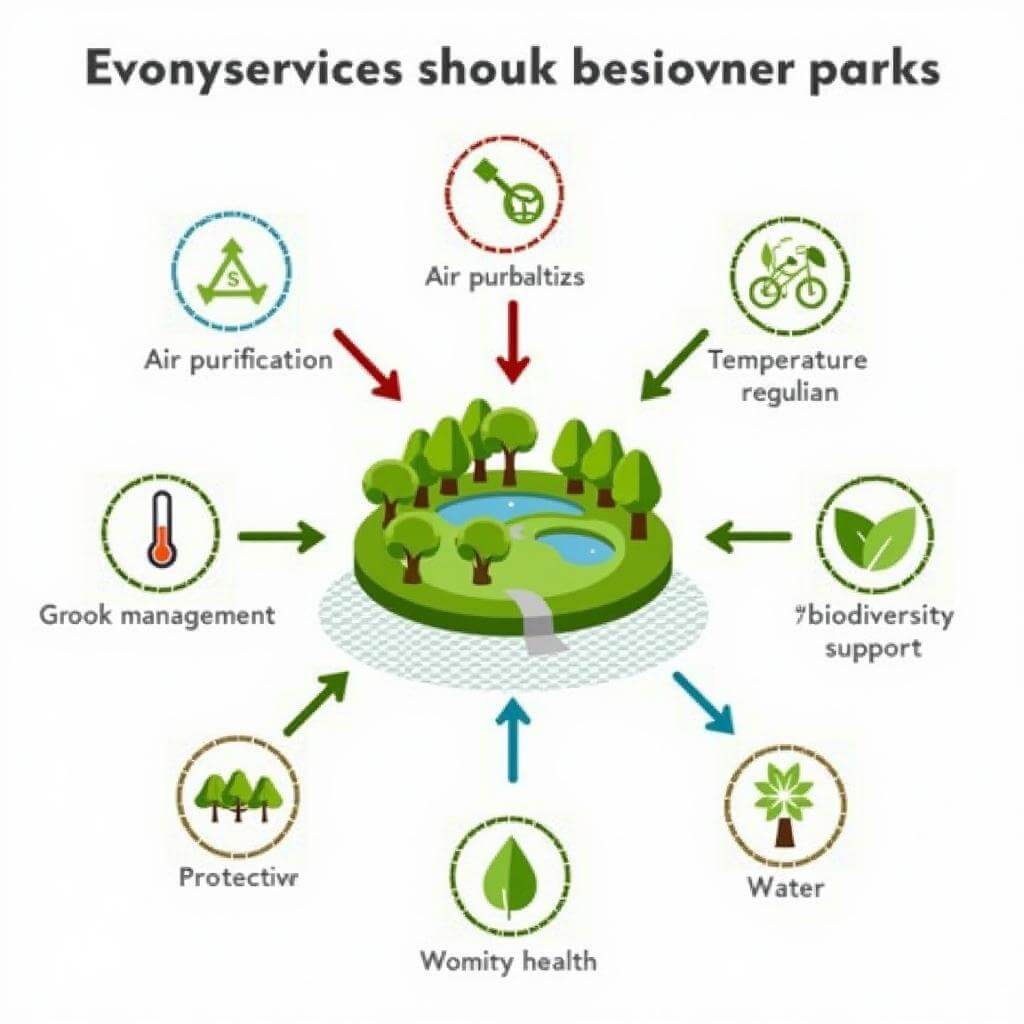When preparing for the IELTS Speaking test, it’s crucial to practice describing familiar places. One common topic that often appears is describing a park you visit frequently. This topic allows candidates to showcase their vocabulary, fluency, and ability to provide detailed descriptions. Let’s explore how to excel in this topic across all parts of the IELTS Speaking test.
Nội dung bài viết
Part 1: Introduction and Interview
In Part 1, the examiner may ask general questions about parks and outdoor spaces. Here are some common questions you might encounter:
- Do you often visit parks?
- What do you usually do when you go to a park?
- Are there many parks in your city?
- Do you think parks are important in urban areas?
Let’s focus on answering the first question:
Sample answer (Band 7-8):
“Yes, I do visit parks quite frequently. There’s a lovely park near my home that I go to at least twice a week. It’s a great way to unwind after a long day at work and get some fresh air. I find spending time in nature really helps me recharge and maintain a good work-life balance.”
Key vocabulary: unwind, fresh air, recharge, work-life balance
Part 2: Long Turn
For Part 2, you might receive a cue card like this:
Describe a park you visit frequently.
You should say:
- Where it is located
- What features it has
- What activities you can do there
- And explain why you like visiting this parkSample answer (Band 8-9):
“I’d like to talk about Central Park, a beautiful urban oasis that I visit regularly. It’s conveniently located in the heart of our city, just a short walk from my apartment.
This park is truly a breath of fresh air in our bustling metropolis. It boasts a diverse range of features that cater to various interests. There’s a serene lake where you can rent paddleboats, well-maintained jogging trails that wind through lush greenery, and several picturesque gardens that are perfect for photography enthusiasts. The park also has state-of-the-art playground equipment for children and spacious meadows ideal for picnics or sunbathing.
In terms of activities, the possibilities are almost endless. You can engage in various sports activities like tennis, basketball, or even yoga classes that are often held on the lawns. For nature lovers, there are guided bird-watching tours and botanical walks. The park also hosts outdoor concerts and cultural events during the summer months, which really brings the community together.
I’m particularly fond of this park because it offers a much-needed escape from the concrete jungle. It’s a place where I can reconnect with nature, get some exercise, and find peace amidst the city’s chaos. Whether I’m going for a jog, reading a book under a shady tree, or simply people-watching, the park never fails to rejuvenate my spirits. It’s not just a green space; it’s a vital part of our city’s identity and a testament to the importance of preserving nature in urban environments.”
 Aerial view of Central Park in New York City
Aerial view of Central Park in New York City
Key phrases: conveniently located, a breath of fresh air, diverse range, serene lake, well-maintained jogging trails, picturesque gardens, state-of-the-art, spacious meadows, sports activities, guided bird-watching tours, botanical walks, outdoor concerts, cultural events, escape from the concrete jungle, reconnect with nature, find peace, rejuvenate my spirits
Follow-up questions:
- How often do you visit this park?
- Has the park changed much since you first started visiting it?
Sample answer (Band 8-9):
“I make it a point to visit Central Park at least twice a week, usually early in the morning for a jog or in the evening to unwind after work. It’s become such an integral part of my routine that I feel a bit off-kilter if I don’t get my park time.
Regarding changes, while the core essence of the park remains the same, there have been some notable improvements over the years. The local authorities have done an excellent job of preserving its natural beauty while enhancing its amenities. For instance, they’ve upgraded the playground equipment, installed more eco-friendly lighting, and improved the accessibility for people with disabilities. There’s also been a concerted effort to increase biodiversity, with new native plant species being introduced and more areas left deliberately wild to support local wildlife. These changes have really elevated the park experience without compromising its character.”
Key phrases: off-kilter, notable improvements, preserving its natural beauty, enhancing its amenities, upgraded, eco-friendly lighting, accessibility, increase biodiversity, deliberately wild, elevated the park experience
Part 3: Two-way Discussion
In Part 3, the examiner might ask more abstract questions related to parks and urban green spaces. Here are some potential questions:
- What role do parks play in modern cities?
- How can governments encourage people to use parks more?
- Do you think there’s a need for more parks in urban areas? Why or why not?
Let’s focus on answering the first question:
Sample answer (Band 8-9):
“Parks play a multifaceted role in modern cities, serving as much more than just green spaces. Firstly, they act as the lungs of the city, helping to purify the air and combat pollution. This is particularly crucial in densely populated urban areas where air quality is often a concern.
Secondly, parks provide essential recreational spaces for city dwellers. In a world where many people live in small apartments, parks offer a place for physical activities, relaxation, and social interaction. They promote public health by encouraging exercise and providing a space for stress relief.
Moreover, urban parks are vital for biodiversity. They serve as habitats for various plant and animal species, helping to maintain ecological balance within cities. This is increasingly important as urbanization continues to encroach on natural habitats.
Parks also play a significant role in community building. They act as meeting points for people from all walks of life, fostering social cohesion and a sense of belonging. Many parks host cultural events, farmers’ markets, and outdoor concerts, which further strengthen community bonds.
Lastly, we shouldn’t overlook the economic benefits of parks. They can increase property values in surrounding areas and attract tourists, contributing to the local economy. Well-maintained parks can become iconic landmarks that define a city’s identity, like Central Park in New York or Hyde Park in London.
In essence, parks are multifunctional spaces that contribute to the environmental, social, and economic well-being of modern cities. They’re not just amenities, but necessary components of sustainable urban planning.”
 People enjoying various activities in an urban park
People enjoying various activities in an urban park
Key phrases: multifaceted role, lungs of the city, purify the air, combat pollution, essential recreational spaces, promote public health, vital for biodiversity, community building, economic benefits, multifunctional spaces, necessary components
Vocabulary and Phrases for High Scores
To achieve a high score in IELTS Speaking, it’s crucial to use a range of sophisticated vocabulary and idiomatic expressions. Here are some words and phrases that can elevate your responses when discussing parks:
-
Urban oasis (noun): A peaceful, green area in a city.
Example: “The park is truly an urban oasis in the midst of our bustling city.” -
Biodiversity (noun): Variety of plant and animal life in a particular habitat.
Example: “The park’s biodiversity has increased significantly with the introduction of new native species.” -
Tranquil (adjective): Calm and peaceful.
Example: “I love the tranquil atmosphere of the park early in the morning.” -
To unwind (verb): To relax after a period of work or tension.
Example: “I often visit the park to unwind after a stressful day at work.” -
Verdant (adjective): Green with grass or other rich vegetation.
Example: “The park’s verdant lawns are perfect for picnics and sunbathing.” -
Recreational facilities (noun phrase): Areas and equipment provided for sports and leisure activities.
Example: “The park offers a wide range of recreational facilities, from tennis courts to yoga spaces.” -
To revitalize (verb): To give new life or vigor to.
Example: “Spending time in the park helps revitalize both my body and mind.” -
Ecosystem services (noun phrase): The benefits people obtain from ecosystems.
Example: “Urban parks provide crucial ecosystem services, such as air purification and temperature regulation.”
 Infographic showing ecosystem services provided by urban parks
Infographic showing ecosystem services provided by urban parks
Remember to use these words and phrases naturally and in the appropriate context to showcase your language proficiency.
Tips from an IELTS Speaking Examiner
As an IELTS Speaking Examiner, I’d like to offer some advice to help you achieve a high score:
-
Practice regularly: Familiarize yourself with various park-related topics and practice describing them in detail.
-
Use a range of vocabulary: Incorporate sophisticated words and phrases, but ensure you use them accurately and naturally.
-
Provide specific examples: When describing a park, offer concrete details to make your answer more vivid and engaging.
-
Develop your ideas: Don’t just list features; explain why they’re important or how they affect you and others.
-
Maintain fluency: Aim for smooth delivery, but don’t worry about the occasional pause or hesitation – it’s natural in spoken English.
-
Show enthusiasm: Your tone and manner can enhance the effectiveness of your answer, especially when discussing something you enjoy, like visiting a park.
-
Be prepared for follow-up questions: Practice expanding on your initial answers to demonstrate your ability to discuss topics in depth.
By following these tips and regularly practicing your speaking skills, you’ll be well-prepared to excel in the IELTS Speaking test, particularly when it comes to describing parks and other familiar places. Remember, the key is to communicate clearly, confidently, and with a rich variety of language.
If you’re looking for more practice, you might want to describe a place in your city that holds special memories or describe a park or garden in your neighborhood. These topics can help you further develop your descriptive language skills and prepare for a wider range of potential IELTS Speaking questions.


